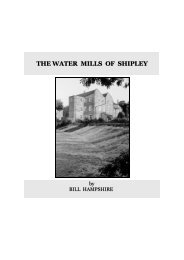IN THE SHADOW OF THE ROSSE - Shipley
IN THE SHADOW OF THE ROSSE - Shipley
IN THE SHADOW OF THE ROSSE - Shipley
You also want an ePaper? Increase the reach of your titles
YUMPU automatically turns print PDFs into web optimized ePapers that Google loves.
The Rhodes’ firm received permission for another block of 8 back-to backs to be built in<br />
Ashley Road in 1878 [14]. This was on a plot abutting onto the Kay’s property [13].<br />
These houses, along with some properties in Bromley Road and Otley Road, which<br />
they owned, were mortgaged to Dr. John Terry, a Surgeon of Bradford. A second mortgage<br />
was then taken out to James Robert Singleton a Bradford timber merchant. The<br />
bankruptcy of the brothers, in 1882, [see below] was probably the reason for them failing<br />
to repay the mortgage, because in 1896 Mr Singleton sold these houses, along<br />
with others in Bromley Road, to Ferguson Marshall Jowett, formerly the landlord of<br />
the Junction Inn, <strong>Shipley</strong>. In 1902 Mr Jowett bought the other mortgage from Dr.<br />
Terry. Mr Jowett himself then took out a mortgage on all this property for £2000, repayable<br />
at £4 5s % per annum. He died in 1919 and the heirs of his estate sold the<br />
houses in Ashley Road to Edith Clough of Ivy Grove for £1000.<br />
In 1877 permission was given to the Rhodes firm for the erection of a temporary<br />
wooden building on Bingley Road, for the use of the Bradford Coffee Tavern. The<br />
idea behind the Coffee Taverns was to provide a non-alcoholic drinking establishment<br />
as an alternative to the public house; and was part of the on-going campaign, during this<br />
period, to encourage people to give up the ‘demon drink’. The precise location of this<br />
building is not yet known, as the Coffee Tavern does not appear in any of the trade<br />
directories of that time. However, if the tavern ever opened, it was probably at the junction<br />
of Ferrand and Bingley Roads, as there was a wooden building on this site around<br />
about this date.<br />
It would appear that the dispute of 1875, which had cause the break-up of the family<br />
business, worsened over the years. In July 1881, William and Murgatroyd Rhodes were<br />
charged with an assault on a bailiff, Edward Frost, who was attempting to retrieve<br />
goods from Murgatroyd, on behalf of their brother, Thomas. Thomas’s wife, Elizabeth<br />
Ann, was also assaulted in the mêlée. The full details of the family quarrel were not<br />
disclosed in court, but William was fined 20 shillings, i.e. £1. 14<br />
In spite of their problems, the firm of Rhodes Brothers Ltd. remained very active<br />
as building contractors throughout this period. Among their other <strong>Shipley</strong> projects<br />
were houses in Bromley Road (1877); Dallam Road (1881); and the Salvation<br />
Army Citadel in Rhodes Place (1893). They also had several contracts from the county authorities,<br />
for building work on various schools throughout the West Riding; and from<br />
railway companies for various station buildings. 15<br />
In the 1881 census, Thomas and Elizabeth Ann Rhodes are shown to be living at 11,<br />
Oastler Road, which was the largest house within this block [11]. The census also shows<br />
Thomas at this time to be a, ‘Contractor - employing 60 men and 20 boys’. The Rhodes’<br />
seem to have moved house quite often. Over the years, they lived in many of the houses<br />
that they had built within this area. At the time of his death, in 1917, Thomas was residing<br />
at No. 4 Robinson Street [27], which backed onto the houses facing Ashley Road.<br />
In the early years of this building project, the Rhodes firm had their base at the northern<br />
end of the Queen’s Rd/Ferrand Rd site, fronting Bingley Road [15]. The evidence<br />
for this comes from a threatened prosecution from the Local Board who were reacting<br />
to a complaint about the amount of dirty smoke coming from their engine chimney (a<br />
steam crane?) in their builders yard. 16 But later, in 1877, they moved to new premises,<br />
in a worked-out quarry at the top of Oastler Road, which would be their main base for<br />
the next forty years [21]. They then sold the vacated site to Mr John Burgess, their<br />
10



